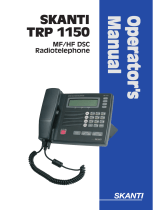In order to ensure the availability of the maintenance requirements specified in
SOLAS Reg. IV/15.7, combination of at least two of the following methods should be
taken as may be approved by the flag administrations, while taking into account the
recommendation specified in IMO A.702(17):
duplication of equipment;
• shore-based maintenance; or
• at-sea electronic maintenance capability.
All ships irrespective of the methods used should make all manufacturers’ installation
manuals and maintenance manuals for all the equipment installed available.
Adequate tools, spare parts and test equipment appropriate to the methods used
by the ship, as specified by the flag administration should be provided and readily
available onboard.
MF/HF radiotelephone with
built-in
DSC/DSC Watch Receiver
Inmarsat-C Mobile Earth Station
NBDP Terminal
Carriage/functional requirements for GMDSS
Inmarsat Solution
MF/HF Solution
Additional equipment to be installed on ships operating in the Sea Areas: Maintenance requirement for ships operating in Sea Area
Functional requirements to be fulfilled by FELCOM18*:
Functional requirements to be fulfilled by FS-xx75* plus IB-585: Functional requirements to be
fulfilled by FELCOM18*:
◆ Transmission and reception of distress and safety
communications using direct-printing telegraphy
◆ Initiation and reception of distress priority calls
◆ Continuous watch on shore-to-ship distress alerts,
incl. those directed to specially defined geographical area
◆ Transmission and reception of general communications
using either radiotelephony or direct printing telegraphy
◆ Distress and safety communications on all distress and safety frequencies
on MF and HF bands
using DSC using radiotelephony using direct printing telegraphy
◆ Continuous DSC watch on 2,187.5 kHz, 8,814.5 kHz, and on at least
one of the distress and safety frequencies:
4,207.5 kHz, 6,312 kHz, 12,577 kHz or 16,804.5 kHz
◆ Trasnsmission and reception of general radio communications using
radiotelephony or direct-printing telegraphy by MF/HF radio installation
◆ Initiation of the transmission of
ship-to-shore distress alert by radio
services other than HF
◆ Distress and safety communications using
the following frequencies:
• 2,187.5 kHz using DSC and continuous DSC watch
• 2,182 kHz using radiotelephony
1. VHF radio installation capable of
transmitting/receiving DSC on CH 70 as
well as radiotelephony on CH 6, 13 and
16 as well as contionuous DSC
watch on CH 70 and either of the radio
installations listed as 2-a or 2-b below
should be arranged onboard:
An arrangement acceptable to
the flag administration should be
established to ensure adequate
support of the ship for the
maintenance and repair of the
radio installations, i.e., service
agreement with a capable service
provider covering the trading area
of the ship.
Adequate additional technical documentations, tools, spare parts and test equipment
consistent with radio installation and as approved by the flag administration should be
provided onboard so that the maintainer can perform tests and localize and repair faults in
the radio equipment while at sea.
The person who is to conduct at-sea electronic maintenance should either hold an
appropriate certificate as specified by the Radio Regulations or have equivalent at-sea
electronic maintenance qualifications as may be approved by the flag administration, taking
into account the reccomendation specified in Annex 5 of IMO A.703(17).
2-a. MF/HF radio installation for distress and
safety communications on the frequency
bands between 1,605 kHz and 4,000 kHz
and between 4,000 kHz and 27,500 kHz,
using DSC, radiotelephony and direct-
printing telegraphy. Continuous DSC watch
on 2,187.5 kHz, 8,814.5 kHz and on at least
one of the distress and safety frequencies:
4,207.5 kHz, 6,312 kHz, 12,577 kHz or
16,804.5 kHz is also required.
2-b. Inmarsat MES capable of
transmission/reception of distress and
safety communications using direct-
printing telegraphy, initiation/reception
of distress primary calls, continuous
watch on shore-to-ship distress
alerts, incl. those directed to specifically
defined geographical area, and
transmission/reception of general
communications using either
radiotelephony or direct-printing telegraphy
FELCOM18
Inmarsat-C Mobile Earth Station
FS-1575/2575/5075
FS-1575/2575/5075
MF/HF radiotelephone with
built-in
DSC/DSC Watch Receiver
FS-1575/2575/5075
IB-585 NBDP Terminal
IB-585
FELCOM18 Inmarsat-C Mobile Earth Station
FELCOM18
*It should be possible that transmission of distress alerts be
initiated from the navigation bridge.
*It should be possible that transmission of distress alerts be
initiated from the navigation bridge.
*It should be possible that transmission
of distress alerts be initiated from the
navigation bridge.
*It should be possible that transmission of distress
alerts be initiated from the navigation bridge.
Duplication of equipment
Shore-based maintenance At-sea electronic maintenance capability
Functional requirements to be fulfilled by FS-xx75*:
VHF radiotelephone with
built-in
DSC/DSC Watch Receiver
FM-8900S
O R
O R
Other functional requirements
Initiation of transmission of ship-to-shore distress alerts* to be fulfilled by one of the followings:
◆ 406 MHz satellite EPIRB ◆ HF using DSC ◆ Inmarsat-C Mobile Earth Station
*It should be possible that transmission of distress alerts be initiated from the navigation bridge.
MF/HF radiotelephone with
built-in
DSC/DSC Watch Receiver
5 6






